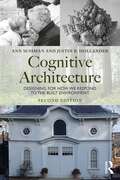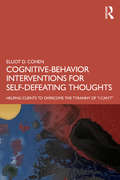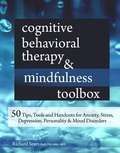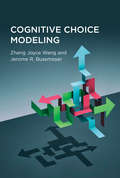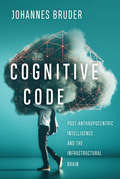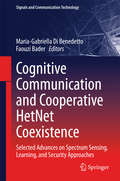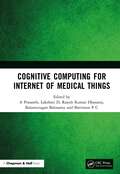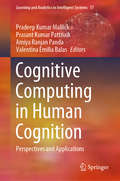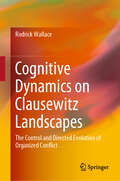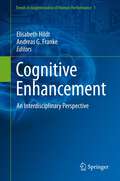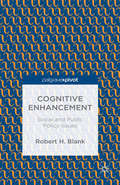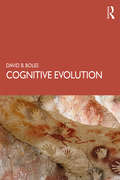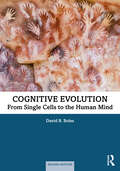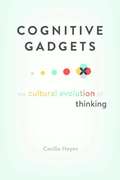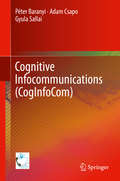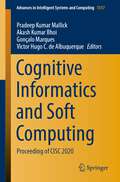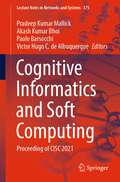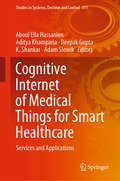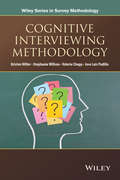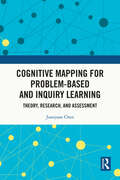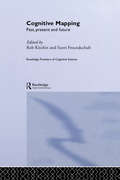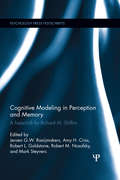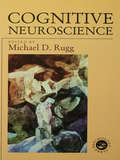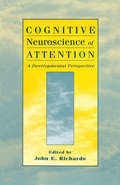- Table View
- List View
Cognitive Architecture: Designing for How We Respond to the Built Environment
by Ann Sussman Justin B HollanderIn this expanded second edition of Cognitive Architecture, the authors review new findings in psychology and neuroscience to help architects and planners better understand their clients as the sophisticated mammals they are, arriving in the world with built-in responses to the environment. Discussing key biometric tools to help designers ‘see’ subliminal human behaviors and suggesting new ways to analyze designs before they are built, this new edition brings readers up-to-date on scientific tools relevant for assessing architecture and the human experience of the built environment. The new edition includes: Over 100 full color photographs and drawings to illustrate key concepts. A new chapter on using biometrics to understand the human experience of place. A conclusion describing how the book’s propositions reframe the history of modern architecture. A compelling read for students, professionals, and the general public, Cognitive Architecture takes an inside-out approach to design, arguing that the more we understand human behavior, the better we can design and plan for it.
Cognitive Behavior Interventions for Self-Defeating Thoughts: Helping Clients to Overcome the Tyranny of “I Can’t”
by Elliot D. CohenIntegrating Cognitive Behavior Therapy (CBT) with a logic-based restructuring of Rational Emotive Behavioral Therapy (REBT), this book provides therapists with a guide for addressing self-defeating thoughts and behaviors. Cohen explores how the tyrannical use of the words "I can’t" creates and sustains many commonplace behavioral and emotional problems. It shows how cognition and affect are intimately connected, demonstrating how cognitive-behavioral interventions help clients to address both their feelings and irrational ideas. Each chapter explores a specific problem, including low frustration tolerance, obsessiveness, risk avoidance, phobias, intolerance to criticism, dependent personalities, and much more. The theories developed throughout are integrated with practice sections and session transcripts that focus on the application of these theories for the treatment of clients who have self-destructive linguistic habits. Cohen also provides resource materials including reflection activities, bibliotherapy, meditation, and step-by-step guidance. This book is essential reading for mental health professionals looking for novel techniques of using CBT, life coaches, positive psychology coaches, counsellors, and academic and clinical researchers who work with CBT.
Cognitive Behavioral Therapy & Mindfulness Toolbox: 50 Tips, Tools And Handouts For Anxiety, Stress, Depression, Personality And Mood Disorders
by Richard SearsCognitive Behavioral Therapy (CBT) has been an effective intervention for decades, but few clinicians have discovered the powerful treatment results of combining CBT with Mindfulness. Clinical psychologist and mindfulness expert Dr. Richard Sears has created a practical, engaging skills manual that clearly defines the principles of CBT and then demonstrates steps for integrating mindfulness practices into therapy -- all drawing from the latest research. Straight-forward explanations and dozens of worksheets provide fresh insights and new tools to move therapy forward when treating stress, anxiety, panic, depression, pain, trauma, addictions, and other issues.
Cognitive Behavioral Treatment of Insomnia: A Session-by-Session Guide
by Carla Jungquist Donn Posner Michael T. Smith Michael L. PerlisCognitive behavior therapy which has been adapted to treat so many problems, has also brought data-driven and data-yielding treatment to insomnia. Focusing on this evidence-based modality, Cognitive Behavioral Treatment of Insomnia is a much-needed treatment manual that provides clinicians with the why’s and how’s of this approach in concise and practical terms. This book, which is written as a reader-friendly guide, is intended for clinical trainees, non-insomnia sleep specialists, and for expert CBT clinicians from outside the sleep medicine field who wish to begin the process of learning to provide empirically validated CBT-I.
Cognitive Choice Modeling
by Jerome R. Busemeyer Zheng Joyce WangThe emerging interdisciplinary field of cognitive choice models integrates theory and recent research findings from both decision process and choice behavior.Cognitive decision processes provide the interface between the environment and brain, enabling choice behavior, and the basic cognitive mechanisms underlying decision processes are fundamental to all fields of human activity. Yet cognitive processes and choice processes are often studied separately, whether by decision theorists, consumer researchers, or social scientists. In Cognitive Choice Modeling, Zheng Joyce Wang and Jerome R. Busemeyer introduce a new cognitive modeling approach to the study of human choice behavior. Integrating recent research findings from both cognitive science and choice behavior, they lay the groundwork for the emerging interdisciplinary field of cognitive choice modeling.
Cognitive Code: Post-Anthropocentric Intelligence and the Infrastructural Brain
by Johannes BruderAs the second decade of the twenty-first century draws to a close, the cultural, social, and economic effects of artificial intelligence are becoming ever more apparent. Despite their long-intertwined histories, the fields of neuroscience and artificial intelligence research are notoriously divided. In Cognitive Code Johannes Bruder argues that seemingly incompatible scales of intelligence – the brain and the planet – are now intimately linked through neuroscience-inspired AI and computational cognitive neuroscience. Building on ethnographic fieldwork in brain imaging labs in the United Kingdom and Switzerland, alongside analyses of historical and contemporary literature, Cognitive Code examines how contemporary research on the brain makes routine use of engineering epistemologies and practices. Bruder elaborates on how the question of mimicking human cognition and thought on the scale of computer chips and circuits has gradually evolved into a comprehensive restructuring of the world through "smart" infrastructures. The brain, traditionally treated as a discrete object that thinks, is becoming part of the larger thinking network we now know as "the Cloud." The author traces a recent shift in the goals of brain imaging to show that the introduction of novel statistical and computational techniques has upset traditional paradigms and disentangled cognition from its biological substrate. Investigating understandings of intelligence from the micro to the macro, Cognitive Code explains how the future of human psychology is increasingly determined by engineering and design.
Cognitive Communication and Cooperative HetNet Coexistence: Selected Advances on Spectrum Sensing, Learning, and Security Approaches (Signals and Communication Technology)
by Maria-Gabriella Di Benedetto Faouzi BaderThis book, written by experts from universities and major industrial research laboratories, is devoted to the very hot topic of cognitive radio and networking for cooperative coexistence of heterogeneous wireless networks. Selected highly relevant advanced research is presented on spectrum sensing and progress toward the realization of accurate radio environment mapping, biomimetic learning for self-organizing networks, security threats (with a special focus on primary user emulation attack), and cognition as a tool for green next-generation networks. The research activities covered include work undertaken within the framework of the European COST Action IC0902, which is geared towards the definition of a European platform for cognitive radio and networks. Communications engineers, R&D engineers, researchers, and students will all benefit from this complete reference on recent advances in wireless communications and the design and implementation of cognitive radio systems and networks.
Cognitive Computing for Internet of Medical Things
by A. Prasanth, D. Lakshmi, Rajesh Kumar Dhanaraj, Balamurugan Balusamy, P.C. SherimonCognitive Computing for Internet of Medical Things (IoMT) offers a complete assessment of the present scenario, role, challenges, technologies, and impact of IoMT-enabled smart healthcare systems. It contains chapters discussing various biomedical applications under the umbrella of the IoMT. Key Features Exploits the different prospects of cognitive computing techniques for the IoMT and smart healthcare applications Addresses the significance of IoMT and cognitive computing in the evolution of intelligent medical systems for biomedical applications Describes the different computing techniques of cognitive intelligent systems from a practical point of view: solving common life problems Explores the technologies and tools to utilize IoMT for the transformation and growth of healthcare systems Focuses on the economic, social, and environmental impact of IoMT-enabled smart healthcare systems This book is primarily aimed at graduates, researchers and academicians working in the area of development of the application of the of the application of the IoT in smart healthcare. Industry professionals will also find this book helpful.
Cognitive Computing in Human Cognition: Perspectives and Applications (Learning and Analytics in Intelligent Systems #17)
by Valentina Emilia Balas Prasant Kumar Pattnaik Pradeep Kumar Mallick Amiya Ranjan PandaThis edited book designs the Cognitive Computing in Human Cognition to analyze to improve the efficiency of decision making by cognitive intelligence. The book is also intended to attract the audience who work in brain computing, deep learning, transportation, and solar cell energy. Due to this in the recent era, smart methods with human touch called as human cognition is adopted by many researchers in the field of information technology with the Cognitive Computing.
Cognitive Dynamics on Clausewitz Landscapes: The Control and Directed Evolution of Organized Conflict
by Rodrick WallaceThis book applies cutting-edge methods from cognitive and evolutionary theories to develop models of conflict between hierarchically-structured cognitive entities under circumstances of imprecision, uncertainty and stress. Characterized as friction and the fog-of-war by the Prussian military theorist Carl von Clausewitz, such conditions impair institutional cognition in real-time conflict and pose a real and continuing threat to organizations, such as the US military. In a linked collection of formal essays and a mathematical appendix, the book explores different aspects of cognitive and evolutionary process as conducted under the direction of doctrine that acts as a kind of genome for retention of what is learned through Lamarckian evolutionary selection pressures: armies and corporate entities learn from conflict, and incorporate that learning into their ongoing procedures. The book proposes models and policy solutions for strategic competence. A central feature of the book is a formal description of the famous OODA loop of the US military theorist John Boyd in terms of the Data Rate Theorem that links control and information theories. That description is expanded to cover more fully the impact of stochastic fog-of-war effects on tactical and operational scales of conflict. Subsequent chapters examine in more detail the role of doctrine, and the particular effect of embedding culture on cognitive and Lamarckian evolutionary processes associated with conflict on tactical, operational, and strategic scales and levels of organization. A scientifically sophisticated exercise in applied mathematics, history, evolutionary theory, and ecosystem theory, this book will be appropriate for researchers and students interested in defense, security, and international relations, as well as non-academic career professionals in government and industry.
Cognitive Enhancement: An Interdisciplinary Perspective (Trends in Augmentation of Human Performance #1)
by Elisabeth Hildt Andreas G. FrankeCognitive enhancement is the use of drugs, biotechnological strategies or other means by healthy individuals aiming at the improvement of cognitive functions such as vigilance, concentration or memory without any medical need. In particular, the use of pharmacological substances (caffeine, prescription drugs or illicit drugs) has received considerable attention during the last few years. Currently, however, little is known concerning the use of cognitive enhancers, their effects in healthy individuals and the place and function of cognitive enhancement in everyday life. The purpose of the book is to give an overview of the current research on cognitive enhancement and to provide in-depth insights into the interdisciplinary debate on cognitive enhancement.
Cognitive Enhancement: Social and Public Policy Issues
by Robert H. BlankRapid advances in cognitive neuroscience and converging technologies have led to a vigorous debate over cognitive enhancement. This book outlines the ethical and social issues, but goes on to focus on the policy dimensions, which until now have received much less attention. As the economic, social and personal stakes involved with cognitive enhancement are so high, and the advances in knowledge so swift, we are likely to see increasing demands for government involvement in cognitive enhancement techniques. The book therefore places these techniques in a political context and brings the subsequent considerations and divisions to the forefront of the debate, situating their resolution within the milieu of interest group politics. The book will provide a starting point from which readers can develop a balanced policy framework for addressing such concerns.
Cognitive Evolution
by David B. BolesCognitive Evolution provides an in-depth exploration of the history and development of cognition, from the beginning of life on Earth to present-day humans. Drawing together evolutionary and comparative research, this book presents a unique perspective on the evolution of human cognition. Adopting an information processing perspective – that is, from inputs to outputs, with all the mental processes in between, Boles provides a systematic overview of the evolutionary development of cognition and of its sensation, movement, and perception components. The book is supported by long-established evolutionary theories and backed up by a wealth of recent research from the growing field of cognitive evolution and cognitive neuroscience to provide a comprehensive text on the subject. Cognitive Evolution is an essential read for advanced undergraduates and postgraduate students of cognitive and evolutionary psychology.
Cognitive Evolution: From Single Cells to the Human Mind
by David B. BolesCognitive Evolution provides an in-depth exploration of the natural history of cognition, from the beginning of life on Earth to present-day humans. Drawing together evolutionary, comparative, and neuroscience research, the book brings a unique cognitive perspective to evolutionary psychology. The second edition features the latest research and illustrations on emerging topics, making it a true update of the field. After introducing evolution, Boles adopts an information processing perspective – from inputs to outputs, with all the mental processes in between to provide a systematic overview of the evolution of cognition, including its sensory, motoric, perceptual, and cognitive components. The combination of evolutionary, comparative, and neuroscience perspectives provides an insight on topics like vision, handedness, tools and planning, spatial perception, pattern recognition, memory, language, and consciousness. Cognitive Evolution is a comprehensive, essential read for advanced undergraduate and postgraduate students of cognitive and evolutionary psychology. Researchers will find it a useful and insightful synthesis of the field, yet even the curious public will find in it much that is surprising and enlightening.
Cognitive Gadgets: The Cultural Evolution of Thinking
by Cecilia HeyesHow did human minds become so different from those of other animals? What accounts for our capacity to understand the way the physical world works, to think ourselves into the minds of others, to gossip, read, tell stories about the past, and imagine the future? These questions are not new: they have been debated by philosophers, psychologists, anthropologists, evolutionists, and neurobiologists over the course of centuries. One explanation widely accepted today is that humans have special cognitive instincts. Unlike other living animal species, we are born with complicated mechanisms for reasoning about causation, reading the minds of others, copying behaviors, and using language. Cecilia Heyes agrees that adult humans have impressive pieces of cognitive equipment. In her framing, however, these cognitive gadgets are not instincts programmed in the genes but are constructed in the course of childhood through social interaction. Cognitive gadgets are products of cultural evolution, rather than genetic evolution. At birth, the minds of human babies are only subtly different from the minds of newborn chimpanzees. We are friendlier, our attention is drawn to different things, and we have a capacity to learn and remember that outstrips the abilities of newborn chimpanzees. Yet when these subtle differences are exposed to culture-soaked human environments, they have enormous effects. They enable us to upload distinctively human ways of thinking from the social world around us. As Cognitive Gadgets makes clear, from birth our malleable human minds can learn through culture not only what to think but how to think it.
Cognitive Infocommunications (CogInfoCom)
by Péter Baranyi Adam Csapo Gyula SallaiThis book describes the theoretical foundations of cognitive infocommunications (CogInfoCom), and provides a survey on state-of-the-art solutions and applications within the field. The book covers aspects of cognitive infocommunications in research fields such as affective computing, BCI, future internet, HCI, HRI, sensory substitution, and virtual/augmented interactions, and also introduces newly proposed paradigms and initiatives under the field, including CogInfoCom channels, speechability and socio-cognitive ICT. The book focuses on describing the merging between humans and information and communications technology (ICT) at the level of cognitive capabilities with an approach towards developing future cognitive ICT.
Cognitive Informatics and Soft Computing: Proceeding of CISC 2020 (Advances in Intelligent Systems and Computing #1317)
by Akash Kumar Bhoi Pradeep Kumar Mallick Victor Hugo C. de Albuquerque Gonçalo MarquesThis book presents best selected research papers presented at the 3rd International Conference on Cognitive Informatics and Soft Computing (CISC 2020), held at Balasore College of Engineering & Technology, Balasore, Odisha, India, from 12 to 13 December 2020. It highlights, in particular, innovative research in the fields of cognitive informatics, cognitive computing, computational intelligence, advanced computing, and hybrid intelligent models and applications. New algorithms and methods in a variety of fields are presented, together with solution-based approaches. The topics addressed include various theoretical aspects and applications of computer science, artificial intelligence, cybernetics, automation control theory, and software engineering.
Cognitive Informatics and Soft Computing: Proceeding of CISC 2021 (Lecture Notes in Networks and Systems #375)
by Akash Kumar Bhoi Pradeep Kumar Mallick Victor Hugo C. de Albuquerque Paolo BarsocchiThis book presents best selected research papers presented at the 4th International Conference on Cognitive Informatics and Soft Computing (CISC 2021), held at Balasore College of Engineering & Technology, Balasore, Odisha, India, from 21–22 August 2021. It highlights, in particular, innovative research in the fields of cognitive informatics, cognitive computing, computational intelligence, advanced computing, and hybrid intelligent models and applications. New algorithms and methods in a variety of fields are presented, together with solution-based approaches. The topics addressed include various theoretical aspects and applications of computer science, artificial intelligence, cybernetics, automation control theory, and software engineering.
Cognitive Internet of Medical Things for Smart Healthcare: Services and Applications (Studies in Systems, Decision and Control #311)
by Aboul Ella Hassanien Deepak Gupta K. Shankar Adam Slowik Aditya KhampariaThis book aims to provide a detailed understanding of IoMT-supported applications while engaging premium smart computing methods and improved algorithms in the field of computer science. It contains thirteen chapters discussing various applications under the umbrella of the Internet of Medical Things. These applications geared towards IoMT cloud analysis, machine learning, computer vision and deep learning have enabled the evaluation of the proposed solutions.
Cognitive Interviewing Methodology
by Kristen Miller Jose Luis Padilla Stephanie Willson Valerie CheppAN INTERDISCIPLINARY PERSPECTIVE TO THE EVOLUTION OF THEORY AND METHODOLOGY WITHIN COGNITIVE INTERVIEW PROCESSESProviding a comprehensive approach to cognitive interviewing in the field of survey methodology, Cognitive Interviewing Methodology delivers a clear guide that draws upon modern, cutting-edge research from a variety of fields.Each chapter begins by summarizing the prevailing paradigms that currently dominate the field of cognitive interviewing. Then underlying theoretical foundations are presented, which supplies readers with the necessary background to understand newly-evolving techniques in the field. The theories lead into developed and practiced methods by leading practitioners, researchers, and/or academics. Finally, the edited guide lays out the limitations of cognitive interviewing studies and explores the benefits of cognitive interviewing with other methodological approaches. With a primary focus on question evaluation, Cognitive Interviewing Methodology also includes: Step-by-step procedures for conducting cognitive interviewing studies, which includes the various aspects of data collection, questionnaire design, and data interpretation Newly developed tools to benefit cognitive interviewing studies as well as the field of question evaluation, such as Q-Notes, a data entry and analysis software application, and Q-Bank, an online resource that houses question evaluation studies A unique method for questionnaire designers, survey managers, and data users to analyze, present, and document survey data results from a cognitive interviewing study An excellent reference for survey researchers and practitioners in the social sciences who utilize cognitive interviewing techniques in their everyday work, Cognitive Interviewing Methodology is also a useful supplement for courses on survey methods at the upper-undergraduate and graduate-level.
Cognitive Mapping for Problem-based and Inquiry Learning: Theory, Research, and Assessment
by Juanjuan ChenThis book studies how to improve problem-based and inquiry-based learning by incorporating cognitive maps. Problem-based learning and cognitive mapping are reviewed from the perspective of both learning sciences and cognitive sciences, including the underpinning theories of experiential learning, situated learning, collaborative learning, meaningful learning, externalized representations and visual representations. The result is a comprehensive review and analysis of cognitive mapping-supported problem-based learning, with the topic discussed from cognitive, meta-cognitive, social, and motivational and emotional perspectives. Furthermore, the author presents a theory-driven design, implementation, and analysis of design-based research to improve problem-based learning using cognitive mapping. The book will provide implications for researchers and practitioners of learning sciences, psychology, instructional systems, and cognitive tools.
Cognitive Mapping: Past, Present and Future (Frontiers of Cognitive Science)
by Rob Kitchin and Scott FreundschuhThis important work brings together international academics from a variety of disciplines to explore the topic of spatial cognition on a 'geographic' scale. It provides an overview of the historical origins of the subject, a description of current debates and suggests directions for future research.
Cognitive Modeling in Perception and Memory: A Festschrift for Richard M. Shiffrin (Psychology Press Festschrift Series)
by Mark Steyvers Jeroen G.W. Raaijmakers Amy H. Criss Robert L. Goldstone Robert M. NosofskyThe work of Richard M. Shiffrin has highly impacted the field of cognitive science, and current developments within perception and memory have been influenced by his ideas. In this volume, several key figures in the field will comment on these developments and put them in a wider perspective. Although many theories and models have been presented in recent years for various aspects of human cognition, there have not been many comparative evaluations that focus on how these models have really advanced our understanding of the underlying mechanisms. This volume will be a valuable source of information for both cognitive scientists working in the field, and researchers and students looking for a clear, accessible presentation of the key problems in cognitive science. Highlighted sections include attention and perception, memory functions and processes, knowledge representation and semantics, modelling approaches and applications.
Cognitive Neuroscience (Studies in Cognition)
by Michael D. RuggProviding up-to-date and authoritative coverage of key topics in the new discipline of cognitive neuroscience, this book will be essential reading in cognitive psychology, neuropsychology and neurophysiology. Striking a balance between theoretical and empirical approaches to the question of how cognition is supported by the brain, it presents the major experimental methods employed by cognitive neuroscientists and covers a representative range of the subjects currently exciting interest in the field. The nine chapters of the book have been written by leading authorities in their fields. The individual chapters provide "state-of-the-art" reviews of their respective attempts to build bridges between domains of enquiry that, until quite recently, were largely independent of one another. The chapters include two describing the different methods that are now available for non-invasive measurement of human brain activity; another two that discuss various current theoretical approaches to the problem of how information is coded in the nervous system; and single contributions dealing with the neural mechanisms of long-term memory and of movement, the functional and neural architecture of working memory, the organization of language in the brain, and the relationship between perception and consciousness.Cognitive Neuroscience will appeal to advanced undergraduate and graduate students interested in the relationship between the brain and higher mental functions, as well as to established researchers in cognitive neuroscience and related fields.
Cognitive Neuroscience of Attention: A Developmental Perspective
by John E. RichardsThis volume describes research and theory concerning the cognitive neuroscience of attention. Filling a key gap, it emphasizes developmental changes that occur in the brain-attention relationship in infants, children, and throughout the lifespan and reviews the literature on attention, development, and underlying neural systems in a comprehensive manner. Special features include: * a new model of the neural control of eye movements; * a developmental perspective on the burgeoning literature on the cognitive neuroscience of attention; * the integration of ideas, research, and theories across chapters within each section via summary and commentary essays; and * a summary of the most recent work in the developmental cognitive neuroscience of attention by several of the leading researchers in this field.
